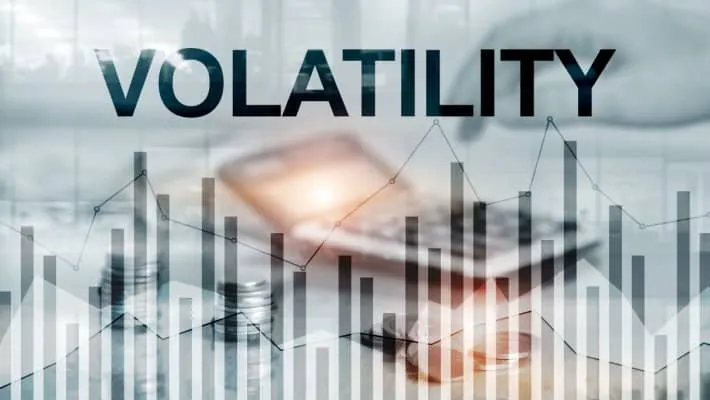Thursday Nov 23 2023 11:52

7 min

Volatility is a term that echoes often in the corridors of finance, from boardrooms to trading floors.
Understanding its implications is essential for anyone participating in financial markets. But, what does it mean, and how to measure volatility?
Let’s learn more about volatility in this article to help you understand this finance term.
Volatility is the amount of uncertainty or risk associated with the size of changes in a security's value.
It is measured by calculating the standard deviation of returns over a given period. High volatility means the price of an asset can change dramatically over a short time period in either direction.
When one speaks of high volatility, it implies that the price of a particular asset has the potential to undergo significant shifts within a relatively brief span.
Such fluctuations can be influenced by a myriad of factors including economic data, geopolitical events, market sentiment, and more.
Conversely, an asset with low volatility tends to have more stable and predictable price movements.
Traders often take advantage of volatility by speculating on stocks, options, and other financial instruments.
For traders, volatility isn't just a measure of risk—it's an avenue for potential profit. As prices swing, opportunities arise.
Savvy traders and investors often seize opportunities from these price fluctuations by trading a range of financial instruments.
Volatility is often used as a proxy for risk in financial markets. Assets with higher volatility are perceived as riskier since their prices can change drastically in a short period. For investors, understanding volatility can help in making informed decisions about risk tolerance and asset allocation.
For traders, especially those looking for short-term opportunities, high volatility can be a goldmine. Price swings provide opportunities to buy at lows and sell at highs. However, it's a double-edged sword: the potential for high returns is accompanied by a higher risk of significant losses.
Market volatility can be caused by a variety of factors including economic data releases, political events, changes in interest rates, and unexpected news or events.
It can also be caused by changes in investor sentiment, speculation and market manipulation.
Economic indicators and data releases, such as GDP growth rates, employment statistics, and inflation reports, play a pivotal role in dictating the health of an economy. The announcement of these figures often leads to immediate reactions in the markets.
Unexpected electoral outcomes or geopolitical tensions can lead to sharp market reactions as investors reassess their strategies in the wake of new political realities.
Central banks around the world use interest rates as a tool to either stimulate economic growth or curb inflation. A change, or even the anticipation of a change, in these rates, can have profound impacts on everything from bond yields to stock valuations.
Unforeseen incidents, such as natural disasters, corporate scandals, or sudden technological breakthroughs, can introduce immediate shocks to the market. The recent history of market crashes often points to unexpected triggers that were external to the regular economic and financial indicators.
A collective shift in the mood of investors, be it optimism or pessimism, can significantly influence asset prices.
Some traders and investors engage in buying and selling based on short-term expectations rather than underlying fundamentals. This speculative activity can magnify price movements, especially in assets that are subject to rumours or are in the media spotlight.
A market is considered volatile if prices change rapidly, unpredictably, and significantly.
Such erratic movements in asset prices can be a result of a host of interconnected factors ranging from macroeconomic data to shifts in investor sentiment.
This can be measured using volatility indices or by analyzing price movements and fluctuations over time.
The volatility Index (VIX), commonly dubbed the "fear index," is the usual metric for measuring volatility.The VIX measures the anticipated volatility of the stock market for the upcoming 30 days, based on option prices from the S&P 500 Index.
Another measure is historical volatility, which calculates the standard deviation of price changes over a specified period. It offers insight into how much an asset's price has fluctuated in the past.
Here are some essential tips to help you manage and mitigate the impacts of market volatility:
No, volatility and risk are not the same. While volatility refers to the frequency and magnitude of price fluctuations in an asset, risk pertains to the probability of not achieving expected returns or losing one's investment.
Volatility can be both advantageous and challenging: for traders seeking short-term opportunities, volatility can offer the potential for significant profits, but it also comes with an increased risk of substantial losses for the unprepared or risk-averse investor.
Ultimately, the perception of volatility as good or bad is influenced by your trading approach and your level of comfort with risk.
Volatility, though often seen through the lens of risk, is an inherent aspect of financial markets. For the savvy and the prepared, it can be an opportunity.
For the uninitiated, it can be a challenge. The key lies in understanding, measuring, and strategizing based on this dynamic element of finance.
Whether you're hedging against potential downturns or capitalizing on price swings, understanding volatility is a vital component in the toolkit of financial success.
Kickstart your trading journey with markets.com, an established CFD trading platform designed for both beginners and seasoned traders.
"When considering "CFDs" for trading and price predictions, remember that trading CFDs involves a significant degree of risk and could result in capital loss. Past performance is not indicative of any future results. This information is provided for informative purposes only and should not be considered investment advice."